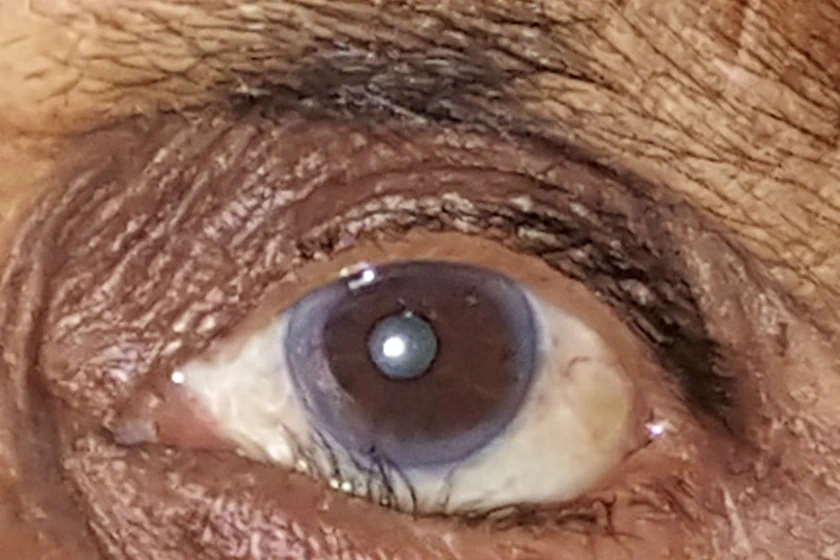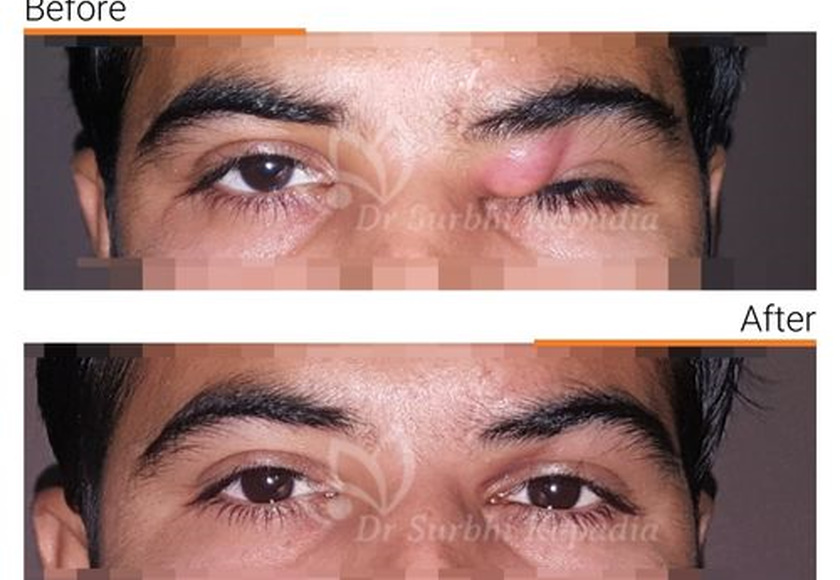|
Getting your Trinity Audio player ready...
|
Did you know?
Entropion, a condition where the eyelid turns inward, affects millions worldwide, with older adults being particularly susceptible due to age-related changes in eyelid structure. If we are talking numbers, its prevalence increases with age: 0.9% for patients 60-69 years old, 2.1% for 70-79, and 7.6% for those over 80.
While symptoms of entropion, such as eye redness, excessive tearing, and sensitivity to light, can greatly impact daily life, the question of treatment looms large.
This article delves into the debate between surgical and non-surgical approaches for entropion treatment, exploring the effectiveness, risks, and considerations associated with entropion correction surgery and alternative methods.
Read ahead as we navigate the complexities of correcting entropion and restoring comfort and clarity to vision.
Quick Overview of Surgical and Non-Surgical Treatment Options
Surgical and non-surgical options exist for treating entropion, a condition where the eyelid turns inward.
Surgical correction involves repositioning the eyelid to alleviate discomfort permanently. Non-surgical methods like eyelid taping and lubricating eye drops offer temporary relief.
Entropion correction surgery is the most effective and permanent solution for severe cases of entropion, providing lasting relief from discomfort and preventing further eye damage.
Non-surgical treatments like eyelid taping and lubricating eye drops offer temporary relief from symptoms of entropion, making them suitable options for milder cases or as interim measures before surgical intervention.
Surgical Approaches for Entropion Treatment
Entropion correction surgery offers long-lasting relief from discomfort and reduces the risk of complications, providing patients with improved eyelid function and enhanced quality of life.
Understanding the surgical techniques, pros and cons, as well as the recovery process and expected results, is essential for individuals considering entropion correction surgery.
Understanding the Entropion Correction Surgery
Entropion correction surgery encompasses various techniques aimed at repositioning the eyelid to its normal anatomical alignment, thereby alleviating irritation and preventing further damage to the eye.
One common surgical approach involves tightening the eyelid muscles to correct the inward turning. This may entail shortening the lower eyelid retractors or tightening the lateral canthal tendon to restore proper tension and positioning of the eyelid margin.
In cases where tissue laxity or horizontal eyelid malposition contributes to entropion, procedures such as lateral tarsal strip surgery may be employed.
During this technique, a strip of tissue from the outer aspect of the eyelid (tarsus) is excised and reattached with sutures, tightening the eyelid and preventing it from turning inward.
Additionally, procedures like anterior lamellar repositioning s may be utilized to address specific anatomical abnormalities and achieve optimal eyelid alignment.
The nuances in Entropion management focus on 2 main pointers-
- Non-surgical management with Botox in selective patients
- Performing correcting surgeries through hidden and cosmetic approaches
Pros and Cons of Entropion Surgical Treatment
Pros of Surgical Treatment for Entropion:
- Provides a permanent solution for severe cases of entropion.
- Addresses underlying anatomical abnormalities responsible for the condition.
- Reduces the risk of complications such as corneal abrasions and infections.
- Offers tailored correction to individual patient needs for optimal outcomes.
- Improves eyelid function and restores normal anatomical alignment
Cons of Surgical Treatment for Entropion:
- Inherent risks associated with any surgery, including infection and bleeding.
Recovery Process and Expected Results
Following entropion correction surgery, patients can expect a short period of swelling, bruising, and discomfort around the surgical site. It is essential to keep the eyes clean and lubricated, as well as to avoid strenuous activities and rubbing the eyes during the initial recovery phase.
Patients may also be prescribed antibiotics and pain medications to manage post-operative symptoms effectively.
Over a few days, as the swelling subsides and the tissues heal, patients typically experience improvement in eyelid position and resolution of symptoms.
While complete recovery may take a week or two most individuals achieve satisfactory outcomes with minimal scarring and restored eyelid function.
Regular follow-up appointments with the ophthalmologist are essential to monitor progress, address any concerns, and ensure optimal healing and long-term success of the surgical intervention.
Non-Surgical Approaches for Entropion Treatment
While the Entropion correction surgery has its fair share of benefits, the non-surgical approaches for Entropion treatment are highly appreciated and accepted as well.
People may choose non-surgical approaches for entropion treatment for immediate symptom relief while awaiting surgery or due to preferences for conservative management. These methods are convenient, accessible, and can be used as preparatory measures before undergoing more invasive procedures.
Understanding the Non-Surgical Methods
Non-surgical methods for treating entropion offer temporary relief from symptoms and can serve as valuable alternatives or complementary measures to surgical intervention. Here, we explore three common non-surgical approaches:
Temporary Eyelid Taping: Eyelid taping involves applying adhesive tape to the eyelid to temporarily reposition it outward, thereby preventing it from turning inward. This method helps alleviate irritation and discomfort caused by entropion by providing support to the eyelid and maintaining proper alignment.
While eyelid taping offers immediate symptom relief, it is a temporary solution and may need to be repeated regularly to sustain its effectiveness. Often times it leads to irritation and contact dermatitis on the delicate eyelid skin.
Botulinum Toxin Injection: Botulinum toxin, commonly known as Botox, can be injected into the muscles surrounding the eye to weaken their contraction, thereby reducing the inward pull of the eyelid.
By temporarily relaxing the muscles responsible for entropion, botulinum toxin injections can help alleviate symptoms and improve eyelid position. However, the effects are temporary and typically last for a few months, requiring repeated injections for sustained relief.
Pros and Cons of Non-Surgical Treatment
Pros of Non-Surgical Treatment for Entropion:
- Offers immediate relief from symptoms such as irritation and discomfort.
Non-invasive and generally well-tolerated, making it suitable for individuals who are bed ridden and unfit to undergo surgeryCan serve as temporary measures while awaiting surgical intervention
Cons of Non-Surgical Treatment for Entropion:
- Temporary nature of relief, necessitating regular repetition or ongoing use for sustained effectiveness.
- Limited efficacy in severe cases of entropion, where surgical correction may be necessary to address underlying anatomical abnormalities.
- Potential for adverse effects or complications, particularly with botulinum toxin injections, requiring careful monitoring and management.
- May not provide long-term solutions or prevent recurrence of entropion, leading to the need for more definitive treatment options.
Efficacy and Long-Term Outlook
The efficacy and long-term outlook of non-surgical treatments for entropion vary depending on the severity of the condition and individual response to treatment.
While these methods offer immediate relief from symptoms and can be valuable in managing mild to moderate cases of entropion, their temporary nature and limited ability to address underlying anatomical abnormalities may necessitate further intervention for sustained relief.
For individuals with severe or recurrent entropion, surgical correction remains the gold standard for achieving long-term resolution and improving overall eyelid function and comfort.
Regular monitoring by a healthcare professional is essential to assess treatment effectiveness, address any complications, and determine the most appropriate course of action for optimizing outcomes and long-term eye health.
Future Directions in Entropion Treatment
The evolution of surgical approaches for entropion correction involves the exploration of minimally invasive procedures and performing these surgeries through aesthetic approaches for quick post-op recovery and gratifying results.
Minimally invasive techniques aim to reduce surgical trauma and enhance patient comfort.
These advancements hold promise for improving surgical outcomes, minimizing complications, and accelerating recovery times for entropion patients.
On the other hand, non-surgical treatments for entropion are undergoing refinement and innovation to enhance effectiveness and patient satisfaction. Research efforts focus on developing biocompatible adhesives for eyelid taping, aiming to improve the adhesion, comfort, and durability of taping applications.
Additionally, advancements in pharmacotherapy explore targeted drug delivery systems and novel formulations of botulinum toxin, with the goal of providing longer-lasting symptom relief with fewer adverse effects.
These advancements in non-surgical methods offer the potential for more tailored and effective management of entropion symptoms, addressing patient needs and preferences.
Potential Combination Therapies and Multimodal Approaches
Recognizing the multifaceted nature of entropion, future treatments may embrace a multimodal approach that combines surgical and non-surgical modalities. By integrating complementary interventions, such as combining eyelid surgery with adjunctive therapies like botulinum toxin injections or eyelid weights, clinicians can optimize treatment outcomes and address both anatomical abnormalities and symptom management.
This personalized approach allows for tailored treatment strategies that consider individual patient characteristics, preferences, and severity of entropion, ultimately leading to improved patient satisfaction and quality of life.
FAQs
Can entropion be repaired without surgery?
Yes, mild cases of entropion can sometimes be managed temporarily without surgery through non-surgical methods like eyelid taping or lubricating eye drops, providing temporary relief from symptoms.
What is the best treatment for entropion?
The best treatment for entropion depends on the severity of the condition. In most cases, surgical correction is necessary to permanently reposition the eyelid and alleviate symptoms.
What happens if entropion is left untreated?
If left untreated, entropion can lead to corneal abrasions, infections, and vision loss due to constant irritation and rubbing against the cornea.
Is entropion surgery necessary?
In severe cases of entropion, surgery is often necessary to prevent complications and restore normal eyelid function.
How much does entropion surgery cost?
The cost of entropion surgery varies depending on factors like the type of surgery needed, surgeon's fees, hospital charges, and location. On average, entropion surgery can cost between ₹25,000 to ₹50,000 in India.
Summary
In conclusion, entropion demands thoughtful consideration and expert intervention to alleviate discomfort and safeguard eye health. Irrespective of your preference- surgical or non-surgical treatment for Entropion, professional healthcare consultation is a must.
With Dr. Surbhi Kapadia’s consultation in Vadodara, individuals facing entropion can find reassurance and personalized care.
Dr. Kapadia’s expertise ensures tailored treatment plans and compassionate support, empowering patients to embark on their journey toward restored comfort and improved vision.
![]()






